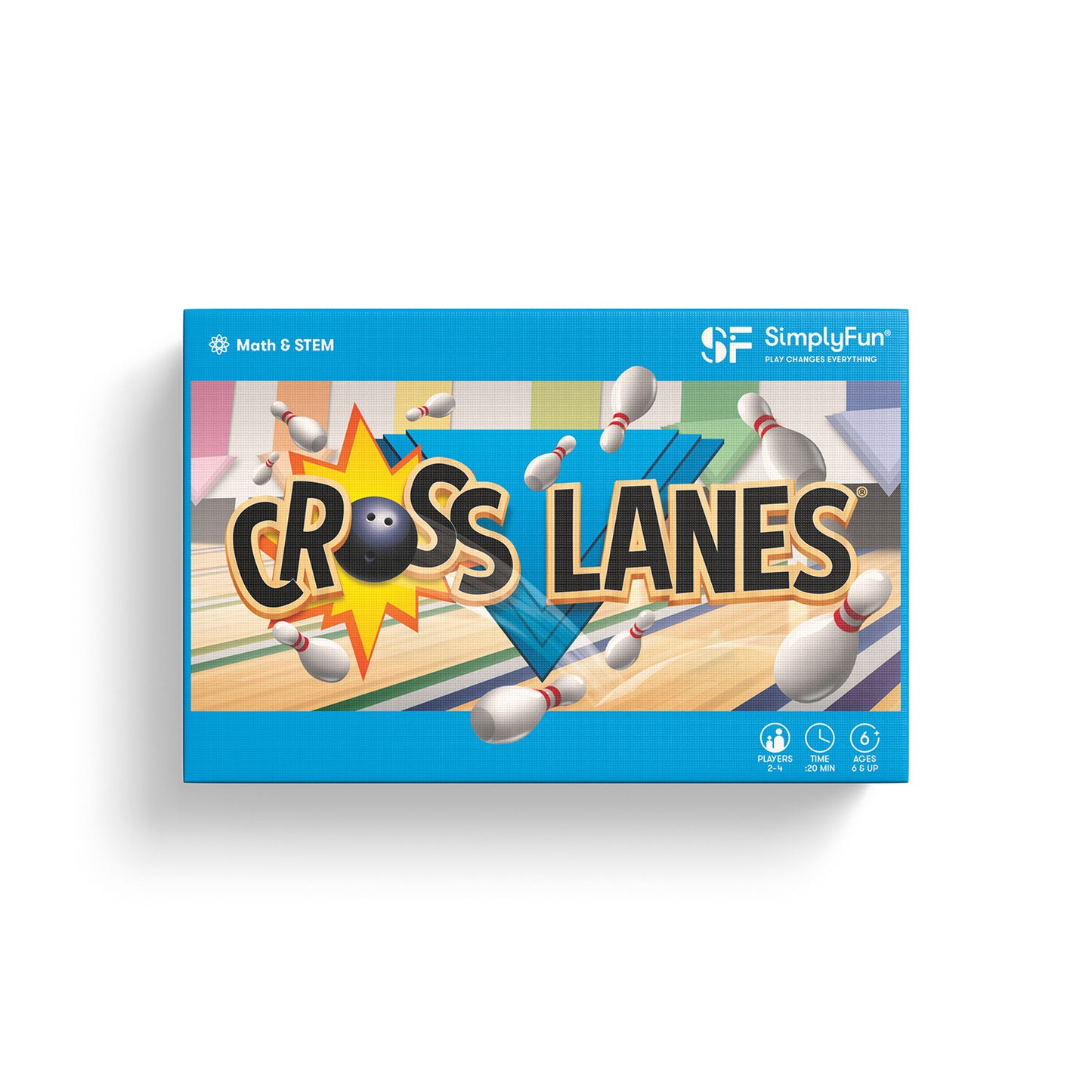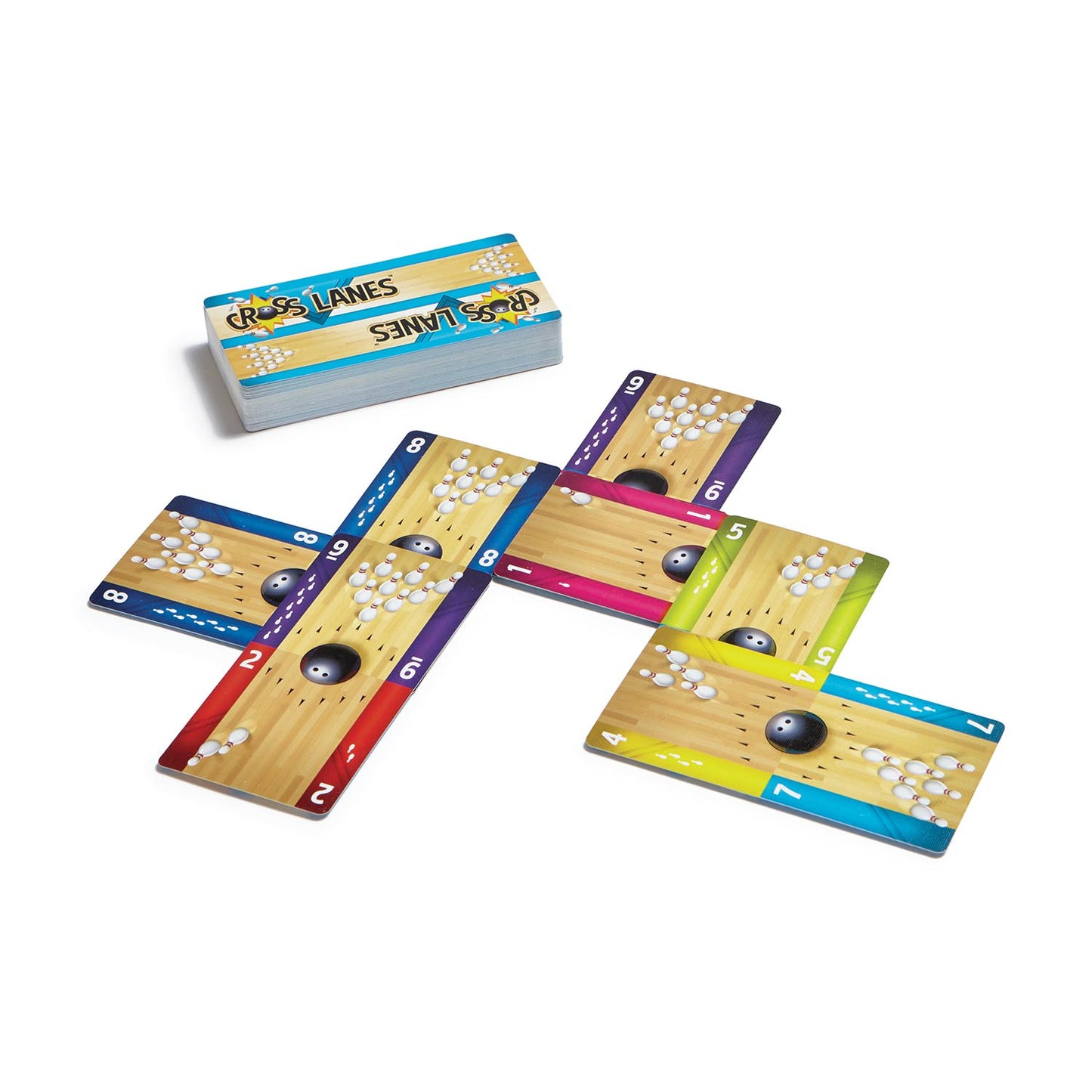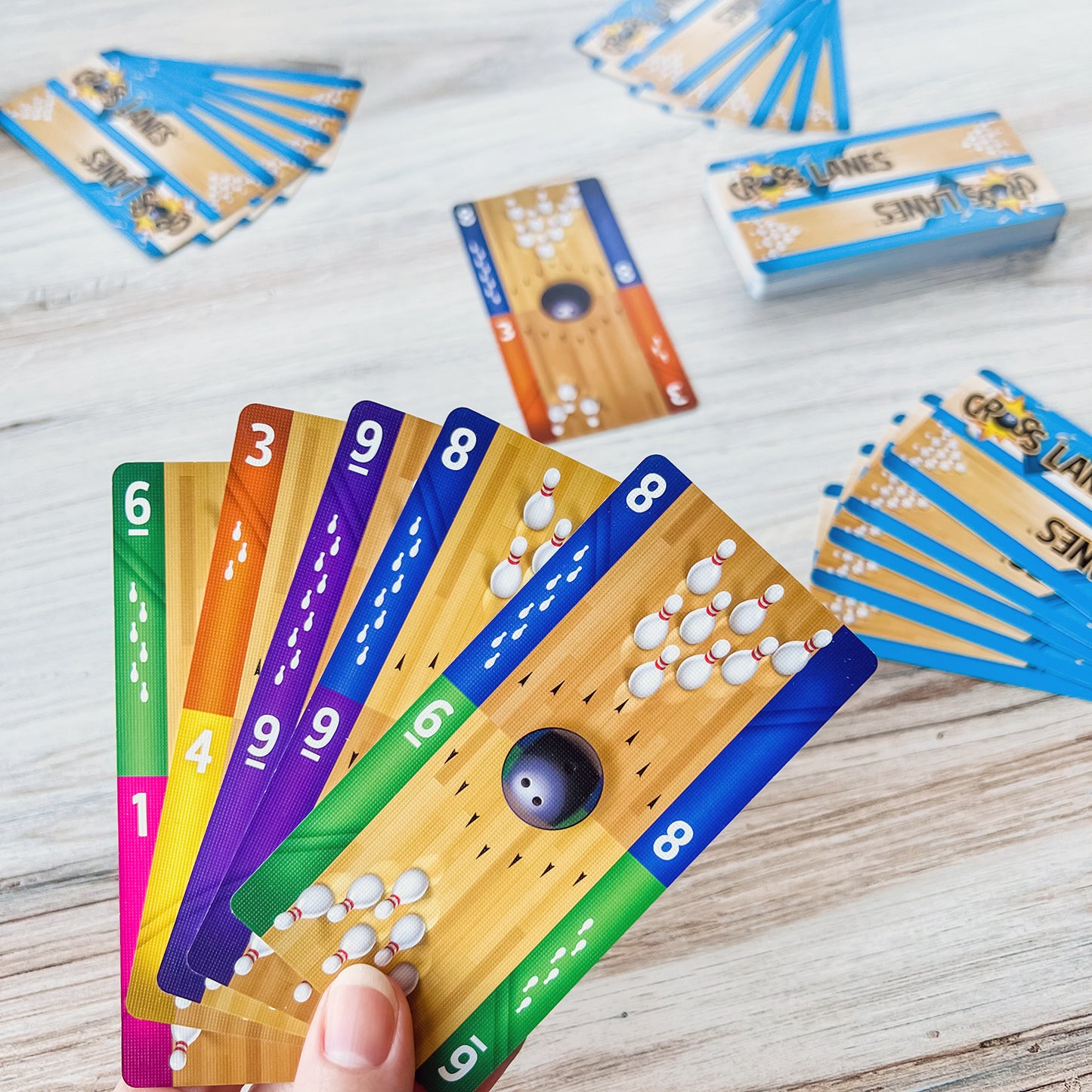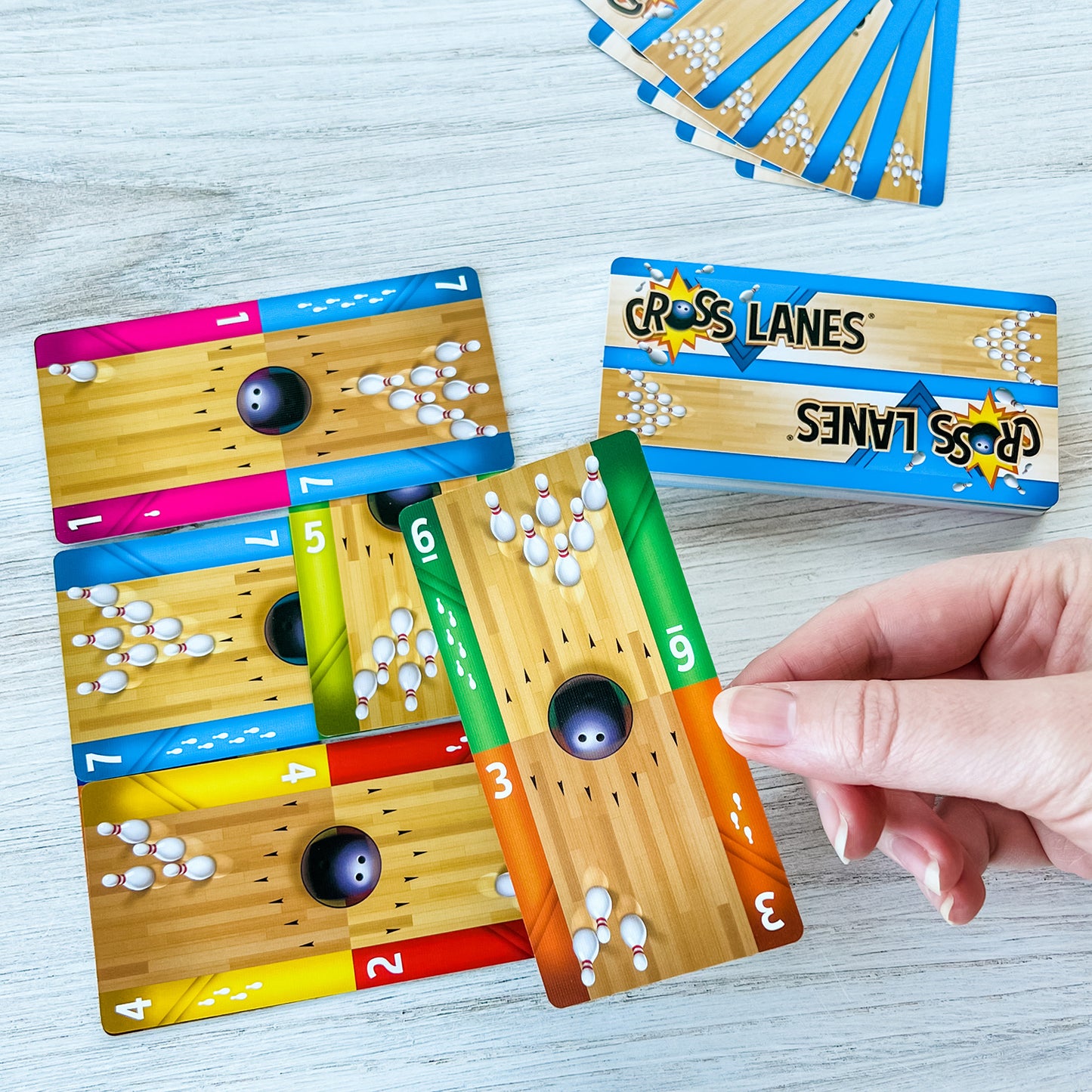




Collapsible content
A game where players try to get a spare or a strike in this bowling themed card game.
You can play Cross Lanes with 2-4 players, ages 6 and up!
Cross Lanes is great for developing Sequencing Skills, as players place their cards based on their numeric value being either plus 1 or minus 1 compared to the numbers already in play.
Cross Lanes also helps develop Planning Skills, as players must pay attention to the cards being played while looking for opportunities to place the cards in their hands.
To set up the game, shuffle the deck and deal each player five cards facedown.
Players should hold their cards but keep them hidden from the other players.
Place the remaining cards facedown next to the play area to create the draw pile.
Turn over the top card from the draw pile and place it faceup in the center of the play area.
The last person that rolled a ball goes first and then play continues clockwise.
The object of Cross Lanes is to take turns placing a card from your hand into the play area. Cards can only be placed over other cards with a value that is either plus 1 or minus 1 compared to the card being placed. The first player to place the last card from their hand in the play area wins the game!
Each Cross Lanes card has two halves with numbers ranging from 1 to 9. Some cards will have the same number on both halves of the card.
Card Placement:
The starting player places one of their cards in the play area. To place a card, the number covered must be one higher or one lower than the number on the player’s card.
For example, a 3 can be placed on a 2 or a 4. After 9 the numbers start over from 1 again, meaning that a 1 can be placed on a 9 or on a 2. Likewise, a 9 can be placed on either a 1 or an 8.
When placing a card, one half of a player’s card needs to cover one half of any card previously placed in the play area, and it must be placed at a 90-degree angle so that the lanes cross.
The next player’s card can then be placed in any of these five positions:
The following are examples of incorrect moves that do not follow the 90 degree-angle rule.
A: A player may not cover both halves of a single card.
B, C and D: Each card must be placed in a 90 degree angle to the card it is overlapping.
Spares and Strikes:
There is one exception to the 90-degree rule: If a player can place a card such that the two halves cover two different cards in the play area, then the card can be placed in any orientation. By having the skill (or luck) to do this, a player can get a spare or a strike.
To get a spare, a player’s card needs to be placed over two other cards in the play area that already overlap. When a spare occurs, the player to the right of the player who played the spare draws one card from the draw pile.
To get a strike, a player’s card needs to be placed over two other cards in the play area that do not touch. When a strike occurs, the players to the right and the left of the player who got the strike each draw one card from the draw pile. If there is only one card left in the draw pile when a strike is played, the player to the right or left with the fewest cards in their hand takes the card.
In a two-player game, getting a strike causes the other player to draw two cards from the draw pile.
If a player cannot place any of their cards in the play area on their turn, it counts as a gutter ball, and that player draws one card from the draw pile, which ends their turn.
If a player plays all their cards before the draw pile runs out, the game ends without a final frame.
The Final Frame:
This is only played if the draw pile runs out. When the draw pile runs out, it causes the final frame phase of the game. The final frame has two key differences from the usual game:
1. A player can extend their turn by playing strikes. Every strike played grants a bonus turn, allowing players to quickly remove cards from their hands. After playing all the strikes they can, a player can then play either a spare or a regular card placement, which ends their turn. Play continues clockwise.
2. Since the draw pile is empty, players do not draw any cards when strikes or spares are played by opponents.
The game ends when a player places the last card from their hand into the play area.
See how many spares and strikes you can bowl playing SimplyFun’s Cross Lanes.


Core Standard*: Math
Math
- Counting and Cardinality
- Compare Numbers Grade Level K


Explore
What Does Child Do To Use Skill In The Game?
Players need to examine game area as play progresses to find options on the board for most points.
How Parents Can Assist Learning
Parents can help children closely examine the orientation of the cards to look for spare and strike opportunities. Also, encourage children to rotate the cards in their hands to help them look for different options. Also suggest that children look at all of their options, rather than settle on the first one they see.
Learning Implications and Educator Support
Educators can help children closely examine the orientation of the cards to look for spare and strike opportunities. Also, encourage children to rotate the cards in their hands to help them look for different options. Children may be tempted to place a card in the first location they see. Remind them of the goal of the game and to look for their best option.
Determine
What Does Child Do To Use Skill In The Game?
Players need to determine whether they can play a card regularly, or for a spare or for a strike.
How Parents Can Assist Learning
Determining which card to play requires identifying locations where at least one of the numbers on the card is one more or less than a card on the table. Simultaneously, children need to determine if they can play the card at a 90 degree angle or for a spare or strike. Encourage children to rotate their card to help visualize options for playing regularly or finding a spare or strike.
Learning Implications and Educator Support
Determining which card to play requires identifying locations where at least one of the numbers on the card is one more or less than a card on the table. Simultaneously, children need to determine if they can play the card at a 90 degree angle or for a spare or strike. Encourage children to rotate their card to help visualize options for playing regularly or finding a spare or strike. Remind children to look at the layout in relation to both ends of their cards.
>Compare
What Does Child Do To Use Skill In The Game?
Comparing is the primary thinking skill used by players in Cross Lanes as they compare the cards in their hands with those on the game area as they look for possible card placement options.
How Parents Can Assist Learning
To help children when learning, encourage them to rotate the cards in their hands; and ask them why the chose one card over another. Understanding children's reasoning can help parents provide guidance and ideas for how to play different cards on future turns.
Learning Implications and Educator Support
Cross Lanes is good for developing flexible thinking skills because children need to consider multiple variables, namely, card orientation, number matching (plus or minus 1) and options for making spares or strikes. Also, comparing and contrasting involves simple addition and subtraction, and evaluation of potential scoring options. To help children when learning, encourage them to rotate the cards in their hands; and ask them why the chose one card over another. Understanding children's reasoning can help educators provide guidance.
Plan
What Does Child Do To Use Skill In The Game?
Players can try to plan for future moves, but need to react to the cards played by opponents. Players have the most control over planning when trying to sequence their cards for the Final Frame in order to play as many cards as possible.
How Parents Can Assist Learning
Thinking about future moves can help children win the game. Parents can remind children to think about what could happen next if they play a certain card so children will plan accordingly. This type of long-term, sequential thinking is important well beyond game play. When children are first learning Cross Lanes, play a few games with all player's hands visible. This way, the children can see how the parent considers different moves, and the parent can give the children hints or ask them questions to help them make the optimal choice.
Learning Implications and Educator Support
Cross Lanes is a good game for helping children develop organizational skills as they plan moves, and adaptive skills as they creatively respond to moves of opponents. Organizing is essential to effective planning and is an important executive functioning skill. Thinking about future moves can help children win the game. Educators can remind children to think about what could happen next if they play a certain card so children will plan accordingly. This type of long-term, sequential thinking is important well beyond game play.
Solve
What Does Child Do To Use Skill In The Game?
Players use their solving skills for an element of Cross Lanes, namely, making spares and strikes.
How Parents Can Assist Learning
Encourage children to take each card in their hand and hold it over the game area, looking for ways to make spares or strikes.
Learning Implications and Educator Support
Cross Lanes helps children develop spatial visualization skills as they imagine how to orient their cards in a way to make a spare or strike. As children are learning this skill, encourage them to take each card in their hand and hold it over the game area, looking for ways to make spares or strikes. The more proficient they become, the more they will be able to visualize the solution mentally, without holding a card over the game area. The game also encourages children to consider two different problems at the same time, when looking for placement for a spare or strike. This is a foundation for solving problems with multiple operations.
*Data compiled from CCSSI ELA Standards, WA Science Standards, and Washington Social Studies Standards


Cognitive
Suggestions for How to Modify Play Experience
Eliminate strike and spare to make the game easier.
Match numbers (ex: 8 to 8) instead of matching based on moving up or down by one prior to matching (ex: 8 to 9). This simplifies the game.
Try playing where cards can be placed in a straight line as well as at 90 degree angles. This makes it easier to play the game.
Communication
Suggestions for How to Modify Play Experience
Communication is not needed. Language can be encouraged by asking children to explain why the card works in a specific spot.
Sensorimotor
Suggestions for How to Modify Play Experience
Not recommended for children with difficulty with fine motor control because Cross Lanes requires accurate placement of cards.
Social Emotional/Behavioral
Suggestions for How to Modify Play Experience
No modifications needed.
Vision
Suggestions for How to Modify Play Experience
Not recommended for children with vision problems.
Hearing
Suggestions for How to Modify Play Experience
No modifications needed.
*Data compiled from CCSSI ELA Standards, WA Science Standards, and Washington Social Studies Standards


Autism Strengths & Interests
Short Summary of Strengths & Interests
- Likes numbers and can count forward to and backwards from 9
- Has good ability to scan visual images to find information such as numbers
- Enjoys spatial reasoning
Is good at matching visual items
This game is not appropriate
Has a good memory for sensory details, including visual, touch, taste and smell
This game is not appropriate
Has a good memory for words, phrases and dialouge
This game is not appropriate
Has a good memory for pictures, numbers and patterns
Is This Game Appropriate? Yes
Description
Cross Lanes is a good game for practicing visual memory skills as players need to look for and remember number combinations and card orientation on the play area. Children who are good with pattern recognition and enjoy playing with numbers will likely enjoy playing Cross Lanes.
Likes to put things in order or a sequence
Is This Game Appropriate? Yes
Description
Many children with autism like to place objects in a sequence. Those children can use that skill to do well at Cross Lanes. On every turn, players are looking to place cards numerically one higher or lower than cards on the play area. Thus sequencing knowledge is an essential feature of playing Cross Lanes.
Learns through visualizing or "replaying" actions in their mind
This game is not appropriate
Likes activities with rules, such as math and phonics
Is This Game Appropriate? Yes
Description
Some children with autism enjoy activities that have clear rules for guiding their experience. Because Cross Lanes is based on number sequencing, it is good for children like this who like math.
Is very concrete and literal
Is This Game Appropriate? Yes
This game is not appropriate
Learns in small "chunks" (for example, phone numbers are 3 chunks of number xxx-xxx-xxxx that are combined together)
This game is not appropriate
Is good at nonverbal reasoning and logic
Is This Game Appropriate? Yes
Description
Cross Lanes does not require verbalization. Children, who are good at problem-solving and logical analysis, yet are uncomfortable talking about their thoughts or reasoning may enjoy the game.
Likes spatial problem solving
Is This Game Appropriate? Yes
Description
Many children with autism are good at thinking in three dimensions and solving problems using spatial orientation. Those children can build that strength with Cross Lanes as they look for the best orientation of a card to score the most points.
Can read well with good vocabulary, though may not fully comprehend content
This game is not appropriate
Likes to use and has good fine motor skill
Is This Game Appropriate? Yes
Description
Some children enjoy playing with and manipulating small objects such as cards. Cross Lanes involves the ability to place cards with good precision on top of other cards, so children with good dexterity can hone that skill with Cross Lanes.
Likes established routines or set ways of doing things
This game is not appropriate
Likes manipulating, constructing or building things
This game is not appropriate
Likes to use and has good musical abilities
This game is not appropriate
Likes to use and has good drawing skills
This game is not appropriate
Autism Special Considerations
Has difficulty understanding complex verbal directions
Is This Game Appropriate for Child with Characteristic? No
Can Child with Characteristic Play Game w/o Modification? No
Strategies for Developing Compensatory Skills:
Directions for spares and strikes are difficult to understand. Children will need multiple demonstrations. It may be easier for children with special needs to eliminate the spare and strike rules.
Uses vocabulary inaccurately or demonstrates echolalia (repeating another's speech)
Is This Game Appropriate for Child with Characteristic? Yes
Can Child with Characteristic Play Game w/o Modification? Yes
Strategies for Developing Compensatory Skills:
Cross Lanes does not require talking. If children demonstrate echolalia, model a phrase that if repeated fits with the game. For example, "Find a card with one more or one less."
Gets stuck repeating a verbal topic or physical actions and/or has difficulty attending to others' actions or topic.
Is This Game Appropriate for Child with Characteristic? Yes
Can Child with Characteristic Play Game w/o Modification? Yes
Strategies for Developing Compensatory Skills:
Try to change the child's topic to the game. Bring attention to what is happening when it is not the child's turn. For instance, hold the card to be played up for the child to see and say, "Look what I am going to play. Can you think where I will put it?" This will help pull the child into the play of others.
Has difficulty producing speech/communication
Is This Game Appropriate for Child with Characteristic? Yes
Can Child with Characteristic Play Game w/o Modification? Yes
Strategies for Developing Compensatory Skills:
Communication is not necessary, but should be encouraged. Ask the child to explain why they put there card in a specific spot. "Which number is one more?"
Has difficulty sequencing multi-step actions and/or doing complex abstract tasks
Is This Game Appropriate for Child with Characteristic? Yes
Can Child with Characteristic Play Game w/o Modification? No
Strategies for Developing Compensatory Skills:
Understanding spares and strikes many be too complex for some children. If this is the case, spares and strikes could be omitted.
Demonstrates difficulty initiating and maintaining social interactions
Is This Game Appropriate for Child with Characteristic? Yes
Can Child with Characteristic Play Game w/o Modification? Yes
Strategies for Developing Compensatory Skills:
Children may need to be reminded that it is their turn. Social interchange can be encouraged by having the child with special needs be the "turn announcer." They point to and announce whose turn it is after each play. This encourages the child pay attention and participate.
Acts out or demonstrates avoidance behaviors when frustrated, overwhelmed, or needs more sensory input.
Is This Game Appropriate for Child with Characteristic? Yes
Can Child with Characteristic Play Game w/o Modification? No
Strategies for Developing Compensatory Skills:
Reduce extraneous noise.
A weighted vest worn during the game may provide additional pressure input and thus reduce fidgeting due to sensory needs. Pressure can be calming when used for no more than 20 minutes at a time.
Practice a phrase to ask for help and role play situations in the game where it is needed.
Provide techniques for self-calming, such as holding a special toy.
Allow time for movement. For example, a child who needs to move frequently can be given an opportunity to 'celebrate' their turn by running around the table or jumping up and down 10 times.
Has short attention span for non-preferred activities
Is This Game Appropriate for Child with Characteristic? Yes
Can Child with Characteristic Play Game w/o Modification? Yes
Strategies for Developing Compensatory Skills:
If the child cannot attend for the whole deck of cards, reduce the size of the deck. This will shorten the game.
Needs sameness or consistent routines and/or has difficulty with transitions from one activity to another
Is This Game Appropriate for Child with Characteristic? Yes
Can Child with Characteristic Play Game w/o Modification? Yes
Strategies for Developing Compensatory Skills:
The game is played the same way with each move, so this will feel comfortable for children with this characteristic. Omit the strike and spare if this is too difficult a shift.
Play games at the same time every day, so the child anticipates the game routine.
Change the location of the game, so the child may play in different rooms, at the table, or on the floor. This will build tolerance for variation.
Prepare the child ahead time for the introduction of a new game. Talk about aspects that will be motivating for the child, and let them explore the parts of the game before setting out the whole game.
Involve the child verbally and with actions for the transition to the game table or at the end of game play. For example, you might say, "Here's a rubber duck. Let's find where it goes?"
Has difficulty understanding others' feelings, intentions, and the reasons for others' actions.
Is This Game Appropriate for Child with Characteristic? Yes
Can Child with Characteristic Play Game w/o Modification? Yes
Strategies for Developing Compensatory Skills:
Understanding what others' think or feel is not needed, but should be encouraged. "Wow! He got a strike! Tell him 'Way to go!'
*Data compiled from CCSSI ELA Standards, WA Science Standards, and Washington Social Studies Standards


Extra Ways to Play the Game
We refer to this variation as How Many Ways Can You Make a Number? Deal out 7 cards. When it is a player's turn, they ask another player for cards that total one of the cards in his or her hand. That player then gives the asking player all the cards that total that amount. It can be one or more cards. For example, a player with a card that has an 8 & 2 asks another player for a 10. If they have it, the other player can give a card with a 7 and 3 on it, or two cards that have a 1 & 4 and a 2 & 3 on them. Cards given away are redrawn from the draw pile. The goal of the game is to get rid of all their cards first. This encourages children to try numerous ways to add up the numbers on their cards. The game ends when all cards in the deck are gone.
Materials Needed
No additional materials
Developmental Benefits
This expansion give children practice in how to add different amounts to get the same number.
Extra Ways to Play the Game
Play the game where you are matching based on one point more or less than the card on the table. However, in this variation, the difference is in the alignment. Cards are not placed on top of each other. Rather, cards can be connected end-to-end for one point; and side-by-side for 2 points. If you can place a card with 3 or more sides aligned to two cards on the table, that is worth 4 points. This would occur in rare instances.
Materials Needed
No extra materials needed.
Developmental Benefits
This variation allows players to think about placement of cards in a different way.
*Data compiled from CCSSI ELA Standards, WA Science Standards, and Washington Social Studies Standards
- Choosing a selection results in a full page refresh.
- Opens in a new window.






